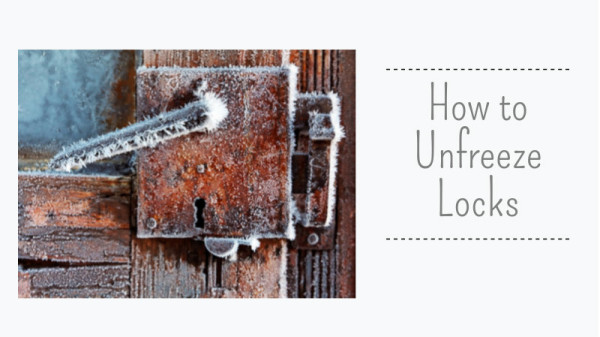One of the most annoying and frustrating experiences in the winter is to open a door or lock, only to discover it is frozen shut! Unfortunately, this is not just aggravating, but also common. It can happen to car doors, front doors, patio sliding doors – basically, any door or lock that’s exposed to water and the winter cold.
Here are a few different approaches to remedy these sticky situations:

- De-icer –
If you have this product already, then you’re in luck! If not, it might be a good idea to head to your nearest hardware or auto supply store and pick up a can. It is designed specifically for this purpose: it melts the ice in the lock, allowing you to open it.
- WD-40 –
If you don’t have the chance to get de-icer just yet, WD-40 and other similar lubricants can help too! Spray it in the lock and wait a few minutes, since it takes a little longer than de-icer to take effect.
- Lighter –
Heat up your key with a lighter (a match can work too). Be careful not to burn your hand! While the key is hot, insert it into the lock, and gently wiggle it around. The heat from the key should melt the ice. The reason it is important to be gentle is that hot metal is more malleable than cold metal. If you try to force the key to turn while it is hot, but the lock is still frozen, you could bend your key out of shape.
- Engine Block –
If you’ve just driven home to find that your front door’s lock is frozen, you have a useful asset sitting in your car. Instead of a lighter, you can use the heat of your car’s engine block to heat the key. Once again, be careful not to burn your hand, and to not bend the key.

- Hot water –
Frozen sliding doors are no less frustrating than front door locks. It is not a good idea to use hot water on a lock, since the water can re-freeze inside of it. However, you can use it on the tracks of a sliding door. Just make sure to wipe up all the excess water as soon as you’ve opened the door to prevent re-freezing.
- Hair dryer –
If you have an outlet and a cord that will reach, you can use a hair dryer to heat up a lock or sliding door tracks until the ice melts.
- Rubbing alcohol –
Isopropyl rubbing alcohol also melts ice and can be used to unfreeze a lock or door.
- Hand sanitizer –
Since hand sanitizer contains some rubbing alcohol, you can also use it! Coat your key with it and work it around inside the lock to melt the ice.
Now that you’ve got your door and lock unfrozen, you’ll want to take measures to make sure it is unlikely to happen again:
- Once again, WD-40 –
Keeping various surfaces of your locks and sliding door tracks well-lubricated will help keep them from binding up when ice accumulates. Apply WD-40 approximately once a week to problem areas.
- Dehumidifier –
If moisture from the inside of your house is the source of the ice, you can keep a dehumidifier near the door to reduce the chances of freezing.
- Turn up the heat –
Keeping the area around the door warm, especially at night can also help prevent freezing.
If you are planning to have a window and door replacement please check with the installation service personal about the types of products that can be used on them. Some products might void the warranty and one should be always certain of it.
Being a home renovator gives me a great satisfaction. The happiness that you bring into someone’s life, just through your work, can’t be expressed in words. I have been in the home improvement industry since quite a long time and have never felt my work anything other than interesting. I consider being a part in bringing someone’s dream come true, the greatest happiness and virtue. – John Medina
